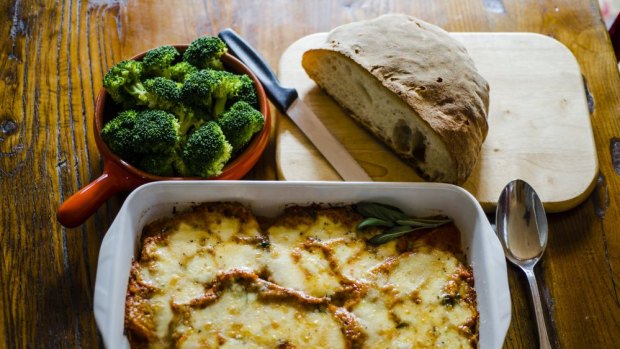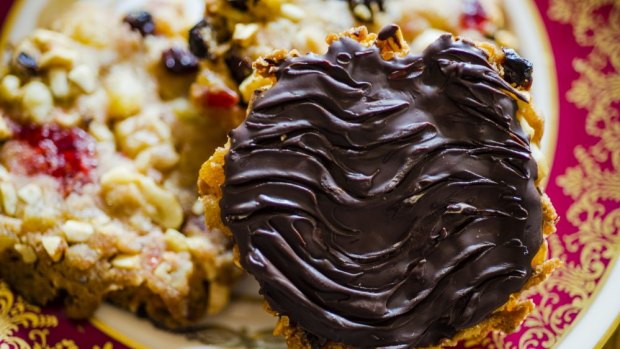By Diana Lampe
Veal parmigiana is an Italian-American classic that is a favourite here as well. It is similar to the Italian eggplant dish - melanzane alla parmigiana. The parmigiana can also be made with chicken or pork schnitzels or crumbed eggplant slices. Some recipes have a slice of ham or prosciutto under the mozzarella.
Chicken schnitzel parmigiana is standard pub food in Australia. If you don’t have the time or inclination to make veal parmigiana from scratch, there are a few shortcuts you can take. Buy the veal already crumbed from the butcher and use a jar of good quality tomato sauce.

Golden and delicious: Veal parmigiana can be prepared in advance.Credit: Jamila Toderas
Much of the preparation for veal parmigiana can be done ahead, like making the tomato sauce and crumbing the veal. I usually crumb a few extra veal schnitzels to keep in the freezer for another day. Veal parmigiana is a great dish for entertaining as it can be completely assembled beforehand and baked when you need it.
Florentines are elegant and delicious biscuits to serve with coffee or tea. They are made with almonds and candied fruits and coated with dark chocolate. Despite the name, there is no evidence to suggest that Florentines are originally from Florence. They are made everywhere in the world today and are particularly popular at Christmas time in the northern hemisphere. I think they would be perfect for us to have for Christmas in July. My recipe is an old one and very easy to do.

Elegant: Florentines are popular world-wide.Credit: Jamila Toderas
Veal parmigiana
Serves 4
4 veal schnitzels
1/2 cup plain flour for dusting
sea salt and freshly ground pepper
2 free-range eggs, lightly beaten
1 1/2 cups dried breadcrumbs
1/2 cup extra-virgin olive oil for frying
120g fresh cow’s milk mozzarella (4-5 bocconcini)
1 small bunch of basil, sage or thyme
1/2 cup (60g) freshly grated parmesan cheese
1 1/2 cups sugo di pomodoro (tomato sauce); see recipe
The tomato sauce can be made ahead of time. The recipe makes more sauce than is needed for four servings of veal parmigiana. The butcher will have already pounded the schnitzels to about 6 millimetres or 1/4-inch thick to make them tender and so they cook quickly and evenly. Otherwise, place them between two sheets of plastic wrap and beat on both sides with a meat mallet or rolling pin.
Crumbing
Set out three shallow dishes for the crumbing. Put the flour with salt and pepper in the first, beaten egg in the second and breadcrumbs in the third. You could also add a little chopped herb or grated parmesan to the breadcrumbs if you wish.
Use one hand for dipping the veal into the beaten egg and the other for coating it with the dry ingredients. One at a time, dust the schnitzels lightly in the flour. Now dip in the egg and hold over the dish to drain off the excess. Then pat and press in the breadcrumbs to adhere and coat thoroughly. Place the crumbed veal on a plate, cover with plastic wrap and rest in the fridge for 30 minutes. The crumbed schnitzels can be frozen at this stage for later use.
Frying
For convenience, the veal can be cooked a couple of hours ahead of time. Heat a generous film of olive oil in a frying pan until fairly hot. Fry the veal in two batches for one or two minutes on each side until golden. Lift out and drain on kitchen towels.
Assembling and baking
The dish can be completely assembled beforehand and kept in the fridge until needed. Take out of the fridge 30 minutes before to come to room temperature. Slice the mozzarella as thinly as you can and set aside. Brush a large shallow baking dish with olive oil. Spread half a cup of the tomato sauce over the base of the dish.
Place the crumbed veal in one layer in the dish slightly overlapping if necessary. Sprinkle with a couple of tablespoons of parmesan cheese, salt and pepper.
Spoon the remaining tomato sauce over the veal to cover and scatter on a little chopped basil, sage or thyme. Lay the mozzarella slices on top of the veal and then sprinkle over the remaining parmesan. Cover the dish with foil so it will heat through more efficiently.
Preheat the oven to 180C. Bake the covered dish for 20 to 25 minutes, then remove the foil and bake for another five to 10 minutes until the dish is really hot and the cheese has melted and is golden. You could do this under the grill.
Garnish with the herb you have used in the dish. Serve hot with Italian bread and a green vegetable such as broccoli.
Sugo di pomodoro
You can use half canned and half fresh tomatoes for a fresh tasting sauce. If you like, add a little tomato paste for a stronger tomato flavour.
2 tbsp extra-virgin olive oil
1 onion, chopped
2 cloves garlic, sliced
1 carrot, chopped
1 stalk celery, sliced
2 bay leaves
sea salt and freshly ground black pepper
2 x 400g cans tomatoes with juice or 800g fresh tomatoes, peeled and deseeded
2 tsp tomato paste (optional)
1 generous pinch of sugar
6-7 basil or sage leaves or 2 sprigs of thyme
Canned tomatoes need only to be chopped, but fresh ones should be peeled and deseeded. Cut a little cross on the ends and place in boiling water for one minute. Lift out and plunge into ice-cold water. Slip off the skins and remove the stalk ends and core. Cut the tomatoes in half and flick out the seeds.
Roughly chop the tomatoes. Heat the oil in a saucepan with the onion, garlic, carrot, celery, bay leaves and salt. Partially cover and cook gently for 10 minutes until softened. Add the tomatoes, tomato paste (if using), sugar, two basil or sage leaves or a thyme sprig and pepper. Simmer with the lid askew for about 45 minutes. Stir from time to time and, if needed, add a dash of water. The sauce is ready when it thickens and the oil separates.
Remove the bay leaves and thyme sprig and puree the sauce with a hand-held blender or food processor. Taste and adjust the seasoning. Chop the basil, sage or thyme and add to the sauce. You will need 1 1/2 cups of sauce for the veal parmigiana.
Florentines
Makes 15-18 biscuits
60g butter
60g brown sugar
1 tsp lemon juice
60g plain flour
60g mixed peel
30g glace cherries (about 5)
30g slivered or flaked almonds
30g walnuts or hazelnuts
30g sultanas
15g stem ginger (preserved ginger)
100g dark chocolate (70 per cent cocoa)
Weigh out the ingredients and chop the fruit and nuts together as finely as you like. Meanwhile, melt the butter and brown sugar gently. Take off the heat and stir in the lemon juice, flour, chopped fruit, ginger and nuts.
Line an oven tray with baking paper. Heat the oven to 180C. Drop heaped teaspoons of the mixture on to the tray leaving two centimetres between for spreading. Press very flat with a fork or your fingers. Bake for about 10 minutes until golden. (Florentines may become hard if overcooked.) Leave on the tray for a couple of minutes to settle and then lift off and place upside down on a rack to cool. Spread with chocolate when cold.
Melt the chocolate in a bowl set over a pan of simmering water. Be sure the bowl doesn’t touch the water and don’t stir until it has melted. Take off the heat and stir until smooth. Leave for a few minutes to cool and thicken. Using a teaspoon spread the chocolate on the underside of the biscuits. When the chocolate is starting to become firm, make wavy lines with the tines of a fork. Keep florentines in an airtight container for a week if you can.
Diana Lampe is a Canberra writer.